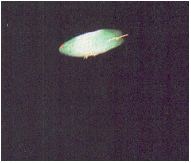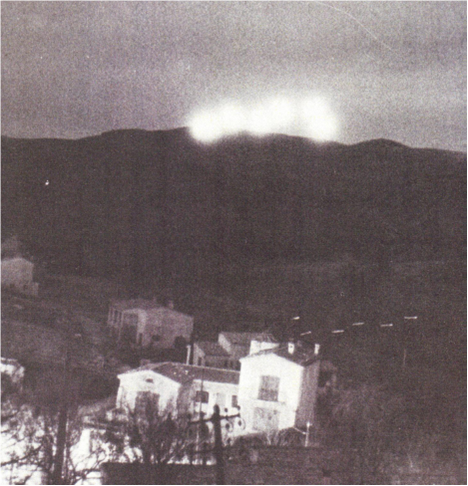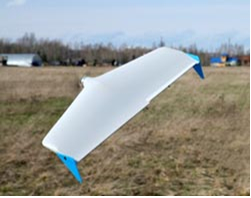Aircrafts
These are undoubtedly a very important source of misidentification. There are numerous different types of such vehicles and we must consider five main ones: ordinary aircraft, military aircraft, advertising planes, gliders, and helicopters. Each has different aspects of relevance to the UAP researcher.
Aircraft can be interpreted as UAP under many circumstances, day and night. In daytime it is quite possible for strong sunlight to reflect from the polished metallic surface and give an appearance of an oval or cigar-shaped object. Protuberances, such as wings, can be made invisible by this. Daylight aircraft approaching along a witnesses’ line-of-sight can also appear as a stationary “domed-disc” for several minutes. Aircraft types vary widely and yet they all have a standardized appearance. Nonetheless, under certain conditions any aircraft can look extraordinary, especially if the witness hears no sound. Some modern jets are quiet, and if a fairly strong wind is blowing away from the witness and towards the aircraft then it could appear to be silent.
At night, aircraft are illuminated for reasons of air safety. The forms of navigation lighting they employ are universally adhered to throughout the world, albeit with some degree of flexibility. By law, an airborne aircraft must bear a steady red light on its left side, and a steady green light on its right (positioned on the wingtips in the case of an airplane). Additionally, they often also bear strobe and/or static white lights (again, in regards to airplanes, on each wing). A reddish/orange flashing anticollision beacon is mounted on the centre of the aircraft’s upper and lower fuselage. Finally, the tail may bear a steady white light, in addition to any other lumination (as described below). Due to these combinations it is possible for a witness to describe all manner of coloured lights. Under certain conditions green can look blue, red can look yellow, and so on. Consequently it is not that important whether or not the lights described conform to the expected aircraft navigation lighting. If the object described by the witness performs as an aircraft would perform then one might conclude this is a feasible explanation.
There are three other aspects of aircraft lighting that must be considered. Firstly, the searchlight. Some aircraft do employ these for ground illumination, but some bright searchlights are also employed at the front of aircraft as landing lights. Although meant only for the final stages of landing, if traffic is light (or conditions are notably foggy) aircraft do switch these on kilometres from touchdown. The sight presented by one of these is spectacular – a single (or two adjacent) brilliant ball(s) of white or yellowish light. If travelling directly towards you it can be seen from many kilometres away, and will appear virtually stationary for up to several minutes. In all probability it will also be quite silent at that distance.
Strobe lighting is becoming more popular nowadays and consists of regular brief flashes of extreme intensity (like a photographic flashgun). It can be seen from some distance, which is one of its chief advantages, but due to its brilliance can lead the eye to see many strange motions and shapes that are not present in reality. Finally, many commercial jets are now using steady white “Logo Lights”. These allow the symbol of the airline, usually on the tail fin, to be visible. Since all manner of symbols are used the world over nobody should be alarmed if flying dragons or fiery lions are seen crossing the sky in the wake of an aircraft!
Another effect to note is the tendency of witnesses to perceive darkened spurious shapes within a configuration of aircraft navigation lights.
It should by now be very apparent that there are so many factors involved in aircraft observation that multiplicities of possible misidentifications exist. Fortunately, it can be a simple matter to confirm or disprove the existence of a civil aircraft in any vicinity at a specific time, provided checks are made fast enough with local airports. There are also standard airways (termed air corridors) along which an aircraft en route must travel. Their location can be checked by reference to major civil airports, and local aviation clubs can supply you with up-to-date maps of these corridors around your area, together with information such as maximum and minimum flying heights allowed along them. There is certainly some justification for checking aircraft movements on every case where this is possible.
Military aircraft present more problems. Civil airports may know of flights or an exercise in their airspace, but it is by no means impossible that they would not. One can check with the nearest military base and they may or may not be co-operative. A great deal depends on the nature of the operation involved. Such aircraft can, of course, fly much faster than civil aircraft, and they sometimes fly in formations. This is true of “refuelling missions”, where one aircraft is fuelled in-flight by another. It is speculated that some stories of “mother ships” and their “baby” UAPs are attributable to the tanker aircraft and one or several smaller jets being refuelled.
Advertising airships (such as the Virgin Lightship) utilise either an aircraft with the capability to fly extremely slow equipped with hundreds of lights on the underside, or an airship with a similar array of lights along its sides. These can be lit up in various sequences to spell out advertising messages and the effect can be remarkable. However, when viewed from a distance and at a shallow angle all that is seen is a random pattern of lights that may zchange or pulsate. Experience in the USA with advertising aircraft has taught that witnesses will read many exotic UAP shapes into these with ease (often perceiving them as a rotating “domed disc”).
Gliders are not flown at night since they would be too dangerous, but in daylight they may look somewhat odd when seen from a distance, and of course there is no sound associated with them.
Then there are helicopters. While infrequently conducted until the 1990’s, night time flying is now becoming increasingly common due to advances in avionics and night vision technology, especially in regard to the military. As with aircraft they are equipped with both a searchlight and navigation lights. Their more notable attributes are manoeuvrability, (much more pronounced than an aircraft, especially during daylight), a lower operational ceiling, generally slower speeds and an ability to hover for extended periods of time. Naturally, sightings of helicopters can be very puzzling (especially at night). The unfortunate thing about aircraft is that it is not always possible to prove that one was in an area, even if one does check right away. Aircraft details are often logged by an airport and you may be able to discover that one was heading inwards (or outwards) from (or to) a certain place, and would pass by the sighting location at a reasonably precise time. However, many airports now ask for substantial search fees to acquire such data, and the present security situation may make them hesitant to supply it in any event, especially to a person previously unknown to them. Another (cheaper) option is to check online flight schedules to determine if any aircraft may have been in the vicinity during the sighting – knowledge of local air corridors and orientations of local airport runways in regard to a “suspect” flight being essential for this approach to be viable. Whatever the method, if one has not traced an aircraft then one must not dismiss the possibility that one was in fact seen.
Telltale signs: Flashing lights (at night), steady speeds (between about 100 and 600 Mph), vicinity of an airport or airway, possible droning or whining sound. Duration usually around 2 minutes up to half an hour.
The last type to consider is UAVs (or Unmanned Aerial Vehicles). Once confined to battlefield and military exercise areas, UAVs are increasingly being used by civilian bodies such as the Police and County Councils for surveillance and similar duties. They are not “robotic” aircraft in the true sense but remotely operated by a ground controller located a relatively short distance away. Most utilise airframes resembling a combination of a missile, model aircraft and/or a helicopter (with some military versions incorporating angular radar stealth “streamlining”). Disc shapes and flying wing designs also exist but are deployed less often. Presently, the optimum size of a UAV is around 15-40 cm or more – smaller variations having very low operational ranges. Larger UAVs, on the other hand, can have an endurance of 2 days or more.
The majority utilise fairly quiet propellers or ducted fans for propulsion. While relatively slow many are capable of hovering (especially those with helicopter configurations) and all have excellent agility. Operational heights tend to be fairly low, and civilian models tend to be used during the day only in ideal weather conditions (i.e. no strong winds, heavy rain or fog).
Telltale signs: A small oval, glider or “rocket” shaped object performing agile motions (with occasional static periods) over a significant public event (rally, football match, etc.), urban area or military exercise/proving ground. The presence of a police surveillance van or similar vehicle may also be noted in the area.



